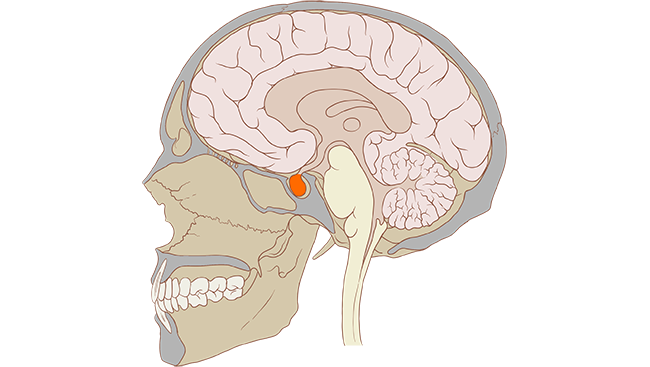Trust in the workplace doesn’t come from authority or job titles: there’s evidence that trust is a simple product of gratitude, validation, and understanding. And that this trust leads to greater efficiency, bonding, and the desire to please—all of which can improve and transform any workplace.
You should trust in the workplace but verify behind the scenes to make sure that the other person isn’t messing with you.
A comprehensive 2017 study noted that verbally expressed gratitude in 129 adult pairs led to significant oxytocin increases.
(Source: Brain Facts) Oxytocin is released from the pituitary gland (in orange).
Oxytocin is a hormone responsible for social and romantic bonding and creates a pleasurable sensation that comes to be associated with the person who triggers it.
Wouldn’t it be nice if you could give some to your manager?
Trust experts weigh in on trust in the workplace.
Paul Zak is the author of Trust Factor: The Science of Creating High-Performance Companies and is well-known for his expertise in workplace trust. He’s also a professor of psychology, management, and economics at Claremont Graduate University and is the founding director of the Center for Neuroeconomics Studies.
Add in being CEO of Immersion Neuroscience, and you have someone who knows what they’re talking about.
“In my research I’ve found that building a culture of trust is what makes a meaningful difference. Employees in high-trust organizations are more productive, have more energy at work, collaborate better with their colleagues, and stay with their employers longer than people working at low-trust companies. They also suffer less chronic stress and are happier with their lives, and these factors fuel stronger performance,” said Paul Zak.
It turns out oxytocin can teach us a lot about working together as a team and building great work relationships, leading to more trust in the workplace. Here’s how it works.
Oxytocin makes us better at working together.
Oxytocin doesn’t just make mammals (including people) more outwardly loving. In general, it makes us more empathetic and trusting—both of which are key to collaboration.
Trust in the workplace is frequently overlooked despite research on its importance. We feel that because we can’t choose our co-workers or managers, whether or not we like or trust them is unimportant. A team that functions on respect and trust is much more likely to be both productive and innovative in the workplace. Of 1,202 U.S. working-age adults surveyed, 23% said they would offer more ideas and solutions, and 21% reported they would be willing to work longer hours if they trusted their leaders.
For this to happen, you don’t need to be physically near people—which is excellent news during a pandemic and increasing remote work. When one reporter used social media to communicate with loved ones, his oxytocin increased by 150%. We can do the same thing with workplace communication, whether it’s via I Done This, Slack, or Trello.
One of the most amazing things about oxytocin is that this “bonding” instinct helps us read social cues.
With so many people working from home, social cues are important because they still allow for that oxytocin release, even if you are not nearby. Oxytocin can still promote trustworthiness if we can “read” nonverbal cues, like eye contact, body language, and fluctuations in voice.
Activating and amplifying this hormone helps us connect with others. Sometimes, that happens serendipitously, but we can also create the conditions for trust at work.
Oxytocin helps teams grow—and so does management structure
In that same Harvard Business Review article mentioned above, Zak’s research team showed that all you need to do to get someone’s oxytocin to go up is to trust them and let them know you do through communication.
“Being trusted to figure things out is a big motivator.” – Paul Zak
The best precursor to communication is to give people autonomy over their work. It sounds counterintuitive, but it shows employees that their managers trust them, and this sign of trust in the workplace also helps to ensure employees are happy at work.
That’s key to retaining your employees.
But just because people work autonomously doesn’t mean it’s clear who’s responsible for what. This is the main disadvantage of a flat workplace structure. Promoting trust in the workplace is difficult if no one is entirely clear on their responsibilities/goals.
Enhancing opportunities for teams to bond is vital to improving your team’s productivity. How can you chip away at that every day?
How to build trust in your team
At I Done This, we understand that meetings are essential. Keeping an open line of communication is crucial to getting stuff done. And it’s important not to keep your employees—especially the “creatives,” who tend to be introverts—isolated. It can also play a massive part in retention and keeping employees happy.
The best way to build your team’s internal trust and keep them producing oxytocin is to make them feel like their work is valued. Here are some ways to do that:
- Communicate outcome measures. Managers should share clear outcome measures with the rest of their team. Transparency about the overall vision and progress of the company shows people how and why their work is essential.
- Schedule check-ins with those who report to you and between teammates. Everyone should get to know everyone so that in the future, they’re more open to working together. It’s also essential to make room for emotional talks to strengthen those connections.
- Provide guidance. Managers should be framed more as a “coach.” Their overall role is to provide advice, which means only constructive feedback.
- Drink with your team. Of course, this shouldn’t be done in excess (or at the office), but it’s an excellent opportunity to get to know your teammates. Plus, drinking alcohol releases oxytocin. Turn any of these team-building exercises into a drinking game! You know, just be reasonable about it.
Implementing small changes in how your team communicates to encourage trust in the workplace can positively impact your team and keep everyone’s oxytocin flowing.

